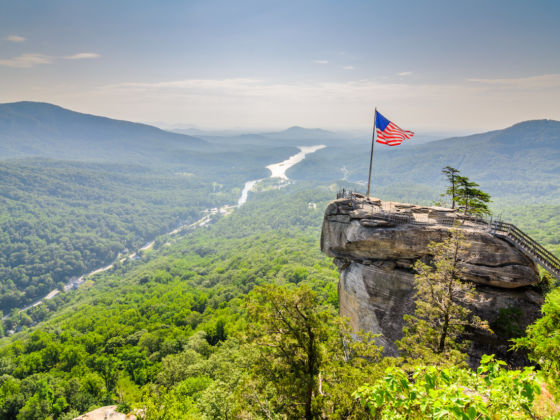WITH WELL OVER 100,000 acres of protected wilderness area, a history as rich in barbecue as it is in the Revolutionary War, and a spot on the map that both mountaineers and sailors can call home, North Carolina tells a complex and varied story. Here are 14 telling examples.
1. The islands off our coast practically have their own language.
The High Tider dialect, or “Hoi Toider,” is only spoken in North Carolina’s Outer Banks and Pamlico Sound regions. Though linguistically a dialect of English, it’s so thick that any outsider unused to deciphering it would be hard-pressed to follow. Punctuation, vocabulary, and grammar can be traced to Southwestern England — to visitors passing through, it sounds nothing short of its own language.
2. You can walk across the nation’s highest suspension footbridge.
Grandfather Mountain (near Linville) is the only private park in the world designated by the UN as an International Biosphere Reserve. On a clear day from the mile-high top, you can see the skyline of Charlotte, 160 miles away. In addition to crossing the 228-foot Mile High Swinging Bridge (bring a scarf and jacket; no matter the weather, you’re still hanging in mile-high air), the park has a number of impressive wildlife exhibits and is right off the Blue Ridge Parkway, sandwiched between dozens of hikes and waterfalls, making for an epic outdoor weekend.
3. We’ve been making beer and wine for hundreds of years — but the scene has never been more exciting.
With more than 140 breweries and brewpubs and 159 wineries, North Carolina is well-versed in local libations. Asheville has Sierra Nevada and New Belgium among many smaller operations like Wicked Weed and Burial Beer Co, and there are over 20 breweries located within the Triangle (Raleigh, Durham, Chapel Hill) alone.
Wineries dot the entirety of the state — which makes sense considering North Carolina’s grapes were remarked upon by explorers and settlers as early as 1584. Though it would take another 250 years for the first commercial winery to pop up (Medoc Vineyard in 1835), by the Civil War North Carolina had 25 wineries operating and thriving, and today the Yadkin Valley in the northwest of the state is a major wine destination.
4. North Carolina is the best place in the US to explore shipwrecks.
North Carolina’s Outer Banks aren’t known as the “Graveyard of the Atlantic” for nothing. Between hurricanes and the meeting of the Gulf Stream and Labrador Currents, the state’s 200-mile string of barrier islands has sunk more than 5,000 ships. Cape Hatteras is home to over 600 shipwrecks alone, making it an obvious spot for the Graveyard of the Atlantic Museum, located in Hatteras Village.
Shipwrecks have been noted from the 1500s through WWII, and many can still be seen to this day with a short dive. Check out Crystal Coast — one of only two spots in the entire US where the warm waters of the Gulf Stream touch shore — for shipwreck exploring, snorkeling, and even underwater photography clinics.
5. We have the highest waterfall in the East.
Upper Whitewater Falls, in Transylvania County — one of nearly 350 waterfalls in North Carolina — measures a total of 411 feet, making it the tallest waterfall on the East Coast. Glassmine Falls in North Carolina may be taller (at a whopping 800+ feet), but it’s classified as “ephemeral” and only flows occasionally. Either way, the entire western border of the state is covered in waterfalls, and viewing even just the most notable ones would keep you busy for a while.
6. Our “Moonshine Capital of the World” gave birth to NASCAR.
During Prohibition, the citizens of Wilkes County made a name for their home as the “Moonshine Capital of the World” by producing illicit booze and selling it widely — and the repeal of Prohibition in 1933 didn’t stop them. To distribute their goods, distillers often had to outrun local and federal police. To outrun the law, they had to modify their vehicles…thus was born the sport of stock-car racing, and eventually NASCAR. The first track, the North Wilkesboro Speedway, held its inaugural race in 1947.
Today, fans can visit the Charlotte Motor Speedway, watch pit crew practice, and tour the Hendrick Motorsports Museum near the state’s capital. You can also relive the heyday of hooch at one of the state’s many modern distilleries.
7. We count blue ghost fireflies and white squirrels among our wildlife.
The North Carolina mountains seem to specialize in weird animalia. The city of Brevard, specifically, is home to white squirrels — not albino squirrels, but white squirrels. Legend has it that after a carnival passed through town in the 1940s, two white squirrels escaped and have since left their mark on future generations. While some don’t believe they exist, they are very, very real.
In the same area lies yet another mystery: blue ghost fireflies. Fireflies (or lightning bugs) are common in many places across the US, but the kind you’ll find here are a different being entirely. Females are flightless and, instead of flashing a pale-yellow color, these little guys glow blue-green like a mutant version of their more commonplace cousins. Scientists don’t know much about them, but they do know their habitats are shrinking. DuPont State Recreational Forest, near Cedar Mountain, is one of the few areas where they can still be seen.
8. America’s largest private home is in Asheville.
With 250 rooms, 8,000 acres, and gardens even Louis XIV would approve of, the Biltmore is as close to Versailles you can get in this part of the world. It was built for the Vanderbilts in the late 1800s when the youngest son fell in love with the scenery and climate and wanted a “little mountain escape.” Over a million visitors tour the grounds each year; if you’re one of them, make sure you have an entire day — between the chateau, the grounds, and a tasting at the most popular winery in the US, your itinerary will be packed.
9. Mount Mitchell is the tallest mountain in the Eastern US.
Sitting 19 miles northeast of Asheville and rising to 6,684 feet, this is the highest point in the Appalachians, and thus the highest point in the Eastern United States. The best part about Mount Mitchell, however, is that NC 128 connects the Blue Ridge Parkway (America’s Favorite Drive) to a parking lot only 1,000 feet from the summit. This short-yet-steep hike takes you to some of the best views on the entire continent.
10. Sorry, California. Cabarrus County, North Carolina, is the site of America’s original gold rush.
In 1799, America’s first gold rush technically began. Technically. A young boy named Conrad Reed found a shiny, 17-pound rock and gave it to his family to use as a doorstop — for the next three years. Eventually his father caught on that this hunk of earth might be worth something, and the history of gold fever in America began. By the early 1820s, North Carolina had become a golden enterprise. Visitors can still tour Reed Gold Mine, today a national historic landmark, and explore its underground mining tunnels in Midland, North Carolina.
11. There’s a laid-back island here where cars aren’t allowed.
No need to leave the continental US for a peaceful island retreat. Bald Head Island, part of North Carolina’s island beaches, is a 20-minute ferry ride from the rest of civilization. While on the island, you’ll travel by golf cart, bike, or on foot (never by car or bus), and the pace of the island mirrors the pace of its travelers. There’s 14 miles of beaches along Bald Head, including a marina and the Old Baldy Lighthouse, and the area is known for sea turtle nesting activity.
12. The University of North Carolina was the first US public university to graduate a class.
In 1789, the state chartered the University of North Carolina in Chapel Hill, and though not the first university to receive a charter, it was the first public university in the country to admit students when it opened in 1795. In its first year, it had a total of 41 students and two professors. Graduating seven of these students in 1798, UNC is the only US public institution to have conferred degrees in the 18th century.
13. North Carolina was the original revolutionary.
With the Mecklenburg Declaration of 1775, North Carolina was the first state to declare independence from England, in addition to being the first state to instruct its delegates to vote for independence from the British crown during the Continental Congress. Some go as far as to say North Carolina instigated the creation of the United States of America. While that’s up for argument, between the mystery of Roanoke Island and the death of Blackbeard, it’s safe to say North Carolina is rich with history, culture, and its fair share of myth.
14. The state is home to the “Grand Canyon of the East.”
The Linville River in Pisgah National Forest sits at the bottom of the 1,500-foot Linville Gorge, which supports an incredibly diverse community of flora and fauna and is an awesome destination for hikers, rock climbers, anglers, and campers. From the visitor center, the strenuous .7-mile Gorge Trail leads to spectacular views at the foot of the roaring Linville Falls, which drenches sweaty hikers in a foggy mist.
You can also access nice panoramic views from multiple outposts on the rim of the gorge. And then there’s the great expanse of terrain open to the public as part of the Linville Gorge Wilderness Area. Note that although it measures 12,000 acres, this is still only the third-largest wilderness area in North Carolina. The Shining Rock and Joyce Kilmer-Slickrock Wildernesses cover nearly 14,000 and 18,000 acres, respectively, making the stretch of land from mountain to coastline called North Carolina an outdoor adventure waiting to happen.

